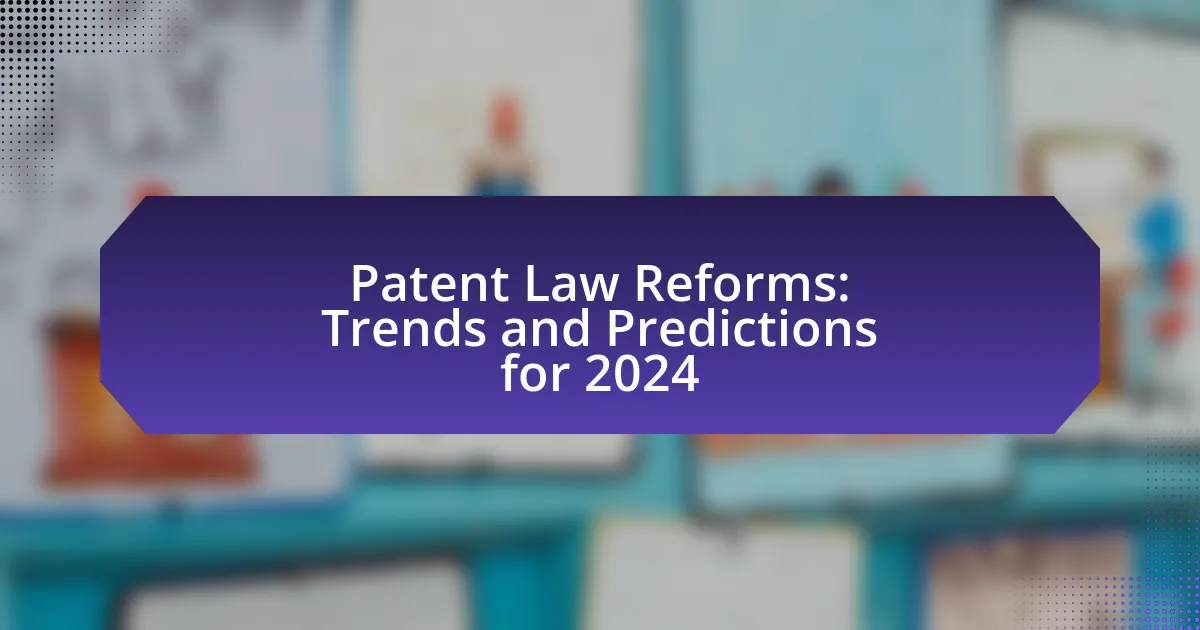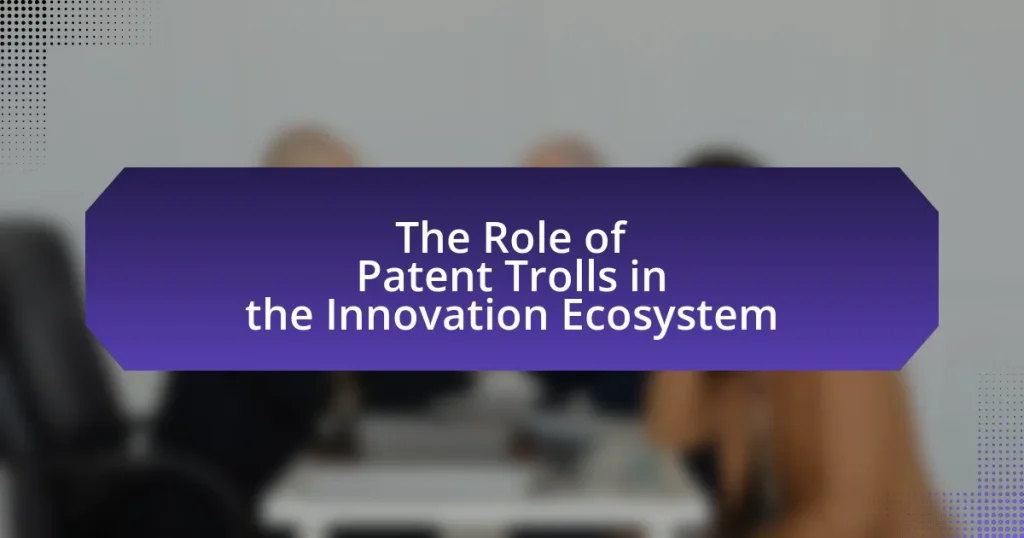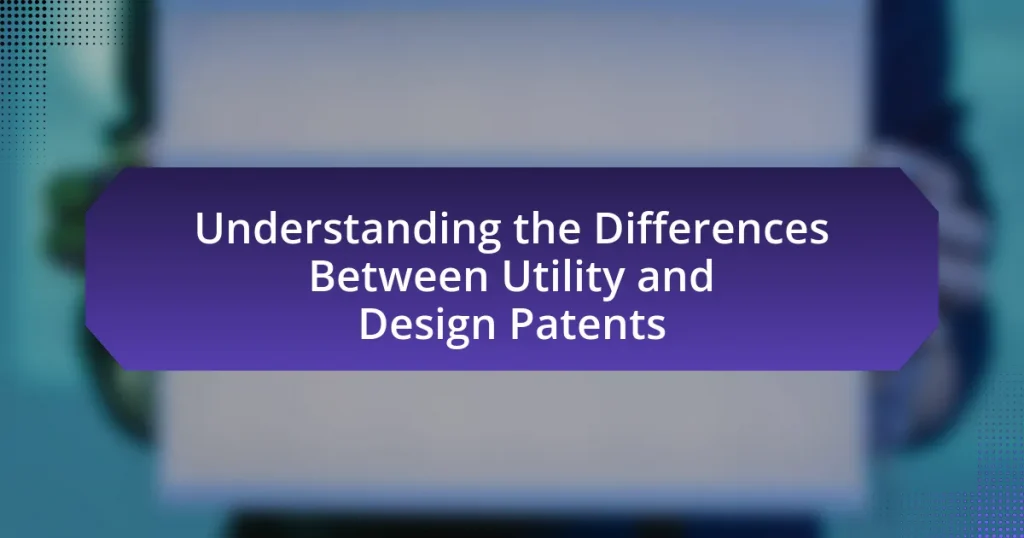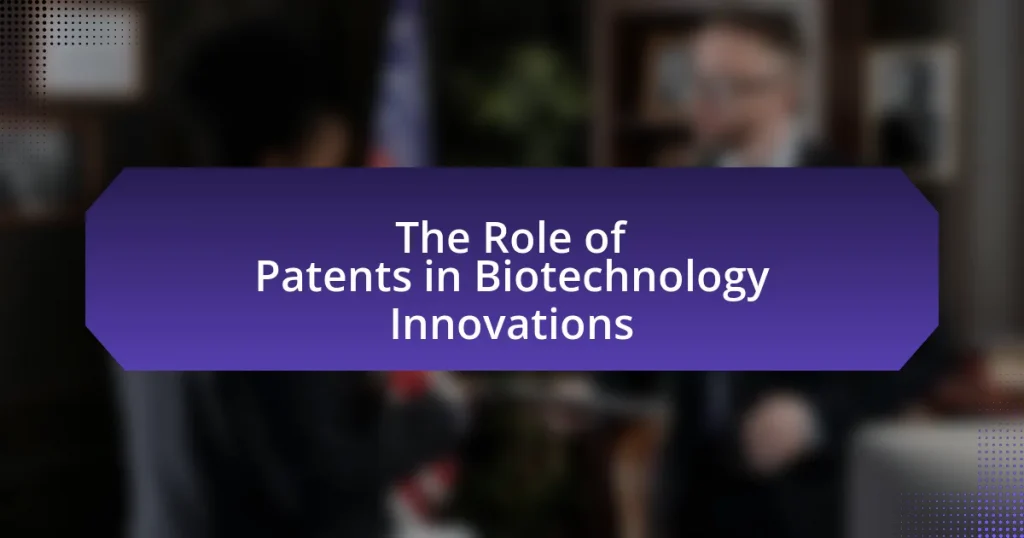The article focuses on Patent Law Reforms and the trends and predictions for 2024. It highlights key developments such as enhancing patent quality, increasing transparency in examination processes, and addressing patent thickets and litigation. The article discusses the evolution of global patent systems through harmonization and digitalization, the impact of technology like AI and blockchain on patent applications, and the emphasis on sustainability in patent law. Additionally, it outlines proposed changes in major jurisdictions, the implications for international cooperation, and strategies for stakeholders to navigate upcoming reforms effectively.
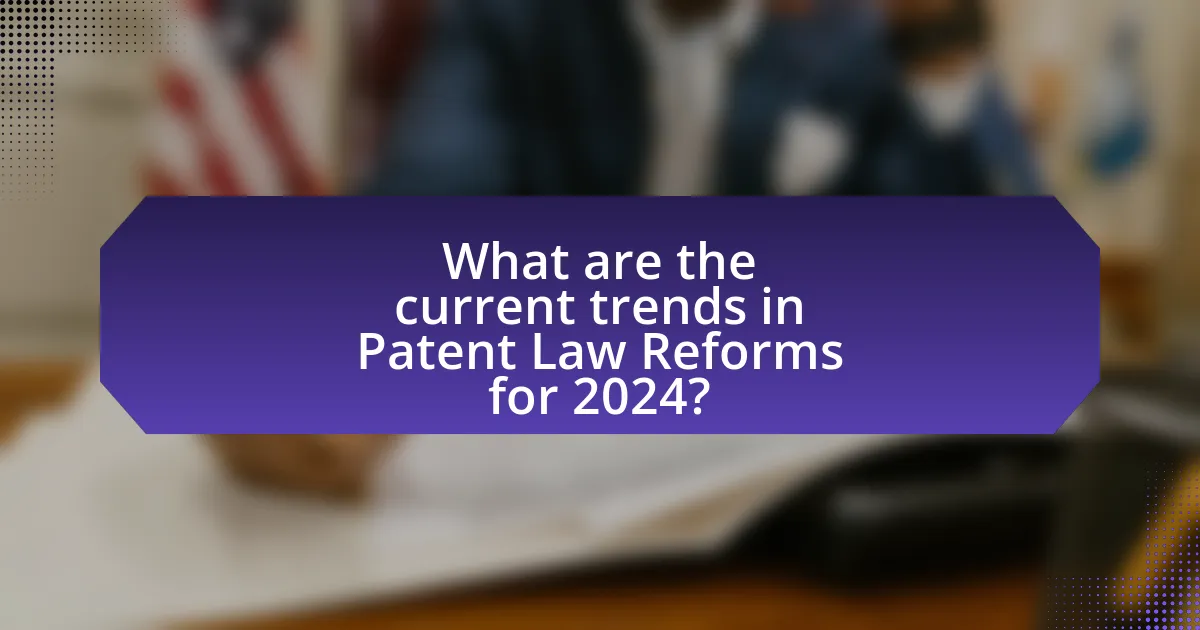
What are the current trends in Patent Law Reforms for 2024?
Current trends in Patent Law Reforms for 2024 include a focus on enhancing patent quality, increasing transparency in patent examination processes, and addressing issues related to patent thickets and litigation. The United States Patent and Trademark Office (USPTO) has proposed initiatives aimed at improving the clarity of patent claims and reducing the backlog of applications, which reflects a broader global movement towards streamlining patent systems. Additionally, there is a growing emphasis on balancing innovation incentives with public access to technology, as seen in discussions around compulsory licensing and patent pools. These trends are supported by ongoing dialogues among policymakers, industry stakeholders, and legal experts, indicating a shift towards more adaptive and equitable patent frameworks.
How are global patent systems evolving in 2024?
Global patent systems are evolving in 2024 through increased harmonization and digitalization. Countries are adopting unified frameworks to streamline patent processes, such as the implementation of the Patent Cooperation Treaty (PCT) enhancements, which aim to simplify international patent applications. Additionally, advancements in artificial intelligence and blockchain technology are being integrated into patent management systems, improving efficiency and transparency. For instance, the World Intellectual Property Organization (WIPO) is promoting digital tools that facilitate easier access to patent information and filing procedures, reflecting a trend towards modernization in patent law.
What changes are being proposed in major jurisdictions?
Major jurisdictions are proposing significant changes to patent law, focusing on enhancing patent quality and streamlining the application process. For instance, the United States is considering reforms aimed at reducing the backlog of patent applications and increasing transparency in patent ownership. The European Union is exploring amendments to the Unitary Patent System to simplify cross-border patent enforcement and reduce litigation costs. Additionally, countries like Japan are advocating for stronger protections against patent trolls to foster innovation. These proposals reflect a global trend towards making patent systems more efficient and accessible, ultimately aiming to balance the interests of inventors and the public.
How do these changes impact international patent cooperation?
Changes in patent law reforms significantly enhance international patent cooperation by streamlining processes and harmonizing regulations across jurisdictions. These reforms often lead to the establishment of unified standards and practices, which facilitate easier filing and enforcement of patents internationally. For instance, the introduction of the Patent Cooperation Treaty (PCT) has already simplified the process for applicants seeking patent protection in multiple countries, reducing costs and time. Furthermore, recent trends indicate a growing emphasis on digital tools and platforms that improve communication and collaboration among patent offices globally, thereby fostering a more integrated international patent system.
What role does technology play in shaping Patent Law Reforms?
Technology plays a crucial role in shaping Patent Law Reforms by influencing the speed and complexity of innovation, which necessitates updates to existing legal frameworks. As advancements in fields such as artificial intelligence, biotechnology, and blockchain emerge, patent laws must adapt to address new challenges related to patentability, enforcement, and infringement. For instance, the rise of AI-generated inventions raises questions about the eligibility of non-human creators for patent protection, prompting legal discussions and potential reforms. Additionally, the increasing use of digital platforms for patent filing and management has led to calls for streamlined processes and enhanced transparency in patent systems. These technological developments underscore the need for patent laws to evolve in order to effectively balance the interests of innovators and the public, ensuring that the legal framework remains relevant and effective in promoting innovation.
How are advancements in AI influencing patent applications?
Advancements in AI are significantly influencing patent applications by streamlining the examination process and enhancing the quality of prior art searches. AI technologies, such as machine learning algorithms, enable patent offices to analyze vast amounts of data quickly, improving the efficiency of identifying relevant patents and literature. For instance, the United States Patent and Trademark Office (USPTO) has implemented AI tools that assist examiners in evaluating patentability, which has led to faster processing times and reduced backlogs. Additionally, AI’s ability to predict trends in innovation helps applicants tailor their submissions to align with emerging technologies, thereby increasing the likelihood of approval.
What are the implications of blockchain technology on patent rights?
Blockchain technology significantly impacts patent rights by enhancing transparency, traceability, and security in the patent application and enforcement processes. The decentralized nature of blockchain allows for immutable records of patent filings, which can reduce disputes over ownership and originality. For instance, a study by the World Intellectual Property Organization (WIPO) highlights that blockchain can streamline the patent registration process, making it easier to establish prior art and verify the authenticity of patents. Furthermore, smart contracts on blockchain can automate licensing agreements, ensuring that patent holders receive royalties in real-time, thus improving compliance and reducing infringement risks.
Why is there a focus on sustainability in Patent Law Reforms?
The focus on sustainability in Patent Law Reforms is driven by the need to address environmental challenges and promote innovation in green technologies. Patent systems are increasingly being adapted to incentivize sustainable practices, reflecting global commitments to climate change mitigation and sustainable development goals. For instance, the World Intellectual Property Organization (WIPO) has emphasized the importance of intellectual property in fostering innovation that contributes to environmental sustainability, highlighting that patents can facilitate the dissemination of green technologies. This shift aims to balance the protection of inventors’ rights with the urgent need for sustainable solutions, ensuring that patent laws support rather than hinder advancements in eco-friendly innovations.
What initiatives are being introduced to promote green technologies?
Governments and organizations are introducing various initiatives to promote green technologies, including financial incentives, regulatory frameworks, and research funding. For instance, the European Union’s Green Deal aims to mobilize investments and provide subsidies for renewable energy projects, while the U.S. Inflation Reduction Act offers tax credits for clean energy production and electric vehicle purchases. These initiatives are designed to accelerate the transition to sustainable energy sources and reduce carbon emissions, reflecting a global commitment to combating climate change.
How do these initiatives affect patent eligibility criteria?
These initiatives broaden patent eligibility criteria by promoting inclusivity for emerging technologies and innovative practices. For instance, recent reforms have aimed to clarify the standards for what constitutes a patentable invention, particularly in fields like artificial intelligence and biotechnology. The U.S. Patent and Trademark Office has issued guidelines that encourage the patenting of software-related inventions, which were previously scrutinized under strict interpretations of eligibility. This shift is evidenced by a rise in patent applications in these sectors, indicating a more favorable environment for innovation.
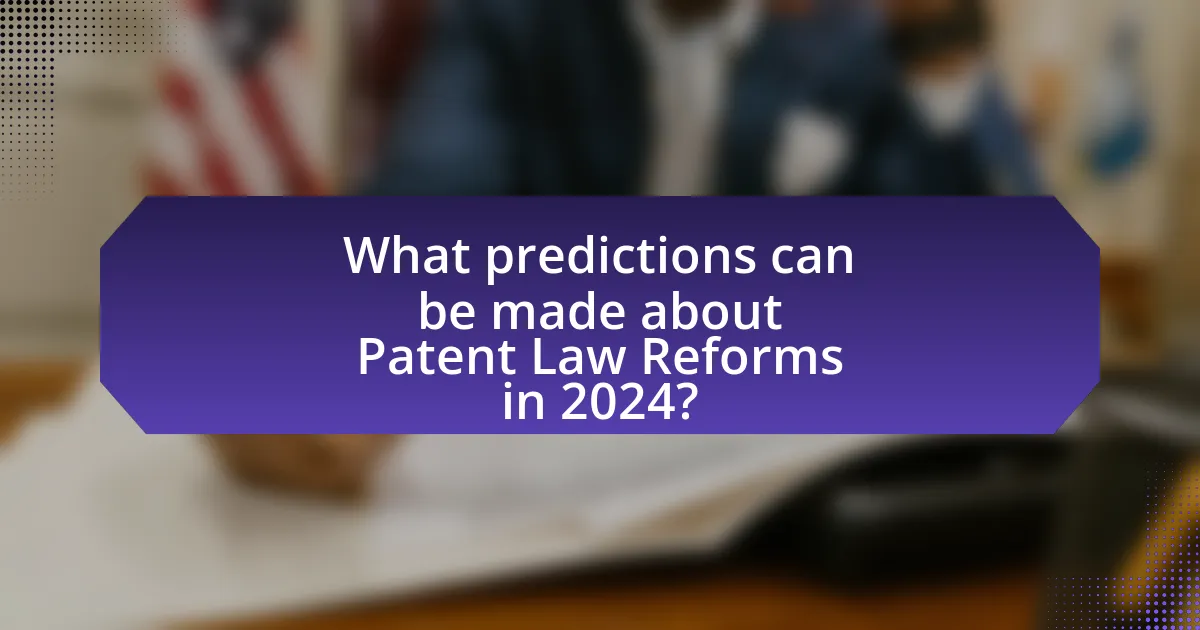
What predictions can be made about Patent Law Reforms in 2024?
Predictions for Patent Law Reforms in 2024 indicate a shift towards increased transparency and efficiency in the patent application process. Legislative bodies are likely to focus on streamlining procedures to reduce backlog and expedite approvals, as evidenced by the growing number of applications and the need for timely innovation in technology sectors. Additionally, there may be a push for harmonization of patent laws internationally, driven by global trade agreements and the need for consistency across jurisdictions. This trend is supported by recent discussions among major economies aimed at aligning intellectual property standards to foster innovation and collaboration.
How might legislative changes impact patent enforcement?
Legislative changes can significantly impact patent enforcement by altering the legal framework governing patent rights and litigation processes. For instance, reforms that streamline patent application procedures or clarify patent eligibility criteria can lead to more efficient enforcement by reducing ambiguity in patent claims. Additionally, changes that increase penalties for infringement or enhance the ability of patent holders to seek injunctions can strengthen enforcement mechanisms. Historical data shows that the America Invents Act of 2011, which introduced significant changes to patent law, resulted in a notable increase in patent litigation, demonstrating how legislative shifts can directly influence enforcement dynamics.
What are the expected outcomes of proposed enforcement reforms?
The expected outcomes of proposed enforcement reforms in patent law include increased efficiency in litigation processes, reduced costs for patent holders, and enhanced protection against infringement. These reforms aim to streamline procedures, making it easier for patent owners to enforce their rights while minimizing unnecessary delays and expenses. For instance, studies have shown that jurisdictions implementing similar reforms have experienced a significant decrease in the average time to resolve patent disputes, leading to quicker resolutions and more predictable outcomes for all parties involved.
How will these changes affect patent litigation trends?
The changes in patent law reforms will likely lead to a decrease in patent litigation trends. Specifically, reforms aimed at streamlining the patent application process and enhancing clarity in patent rights are expected to reduce the number of disputes. For instance, the introduction of clearer guidelines for patent eligibility and enforcement can minimize ambiguity, which often leads to litigation. Historical data indicates that similar reforms in the past have correlated with a reduction in litigation cases, as seen in the aftermath of the America Invents Act of 2011, which resulted in a notable decline in patent lawsuits.
What future challenges are anticipated in the patent landscape?
Future challenges anticipated in the patent landscape include the increasing complexity of technology, which complicates patentability assessments. As innovations in artificial intelligence, biotechnology, and software continue to evolve rapidly, patent offices may struggle to keep pace with the necessary legal frameworks and guidelines. Additionally, the rise of global patent filings creates jurisdictional challenges, leading to inconsistencies in patent protection across different regions. This situation is exacerbated by the ongoing debates surrounding patent eligibility criteria, particularly in areas like genetic materials and software, which may lead to further legal uncertainties. Furthermore, the potential for increased litigation over patent rights, driven by aggressive enforcement strategies and the proliferation of patent trolls, poses significant risks for businesses and innovators.
How might evolving technologies create new patenting dilemmas?
Evolving technologies create new patenting dilemmas by challenging existing legal frameworks and definitions of patentable inventions. As advancements in artificial intelligence, biotechnology, and blockchain occur, traditional criteria for patentability, such as novelty and non-obviousness, become increasingly difficult to apply. For instance, AI-generated inventions raise questions about inventorship and ownership, as current patent laws typically require a human inventor. Additionally, rapid technological changes can lead to overlapping patents and increased litigation, complicating the enforcement of intellectual property rights. These complexities necessitate ongoing reforms in patent law to address the unique challenges posed by emerging technologies.
What are the potential risks of patent thickets in emerging fields?
Patent thickets in emerging fields pose significant risks, including stifling innovation, increasing litigation costs, and creating barriers to market entry. These dense webs of overlapping patents can lead to uncertainty for companies, as they may face challenges in navigating the complex landscape of intellectual property rights. For instance, a study by the National Bureau of Economic Research found that patent thickets can reduce the likelihood of new entrants in industries like biotechnology and software, ultimately hindering technological advancement. Additionally, the costs associated with defending against patent infringement claims can divert resources away from research and development, further impeding progress in these fields.
What strategies can stakeholders adopt to navigate upcoming reforms?
Stakeholders can adopt proactive engagement, continuous education, and strategic collaboration to navigate upcoming patent law reforms. Proactive engagement involves staying informed about legislative changes and participating in public consultations to influence policy outcomes. Continuous education ensures stakeholders understand the implications of reforms on their operations, enabling them to adapt effectively. Strategic collaboration with industry groups and legal experts can provide insights and resources to address challenges posed by new regulations. For instance, organizations like the American Intellectual Property Law Association regularly publish updates and host forums that help stakeholders stay abreast of changes and best practices in patent law.
How can businesses prepare for changes in patent law?
Businesses can prepare for changes in patent law by conducting regular audits of their intellectual property portfolios and staying informed about legislative developments. Regular audits help identify potential vulnerabilities and opportunities for innovation, while monitoring patent law trends allows businesses to adapt their strategies proactively. For instance, the American Invents Act of 2011 significantly altered the patent landscape, emphasizing the importance of ongoing education and adaptation in response to legal changes. By engaging with legal experts and industry associations, businesses can gain insights into upcoming reforms and adjust their practices accordingly, ensuring compliance and competitive advantage.
What best practices should innovators follow to protect their inventions?
Innovators should file for patents to protect their inventions, as patents provide legal rights that prevent others from making, using, or selling the invention without permission. Additionally, innovators should conduct thorough prior art searches to ensure their invention is novel and non-obvious, which are key criteria for patentability. Keeping detailed records of the invention process, including sketches, prototypes, and development notes, can also strengthen a patent application by demonstrating the invention’s evolution and originality. Furthermore, innovators should consider non-disclosure agreements (NDAs) when discussing their inventions with potential partners or investors to safeguard sensitive information. These practices are supported by the fact that patents can significantly increase the commercial value of an invention, as evidenced by a study from the National Bureau of Economic Research, which found that patented inventions are more likely to attract investment and generate revenue.
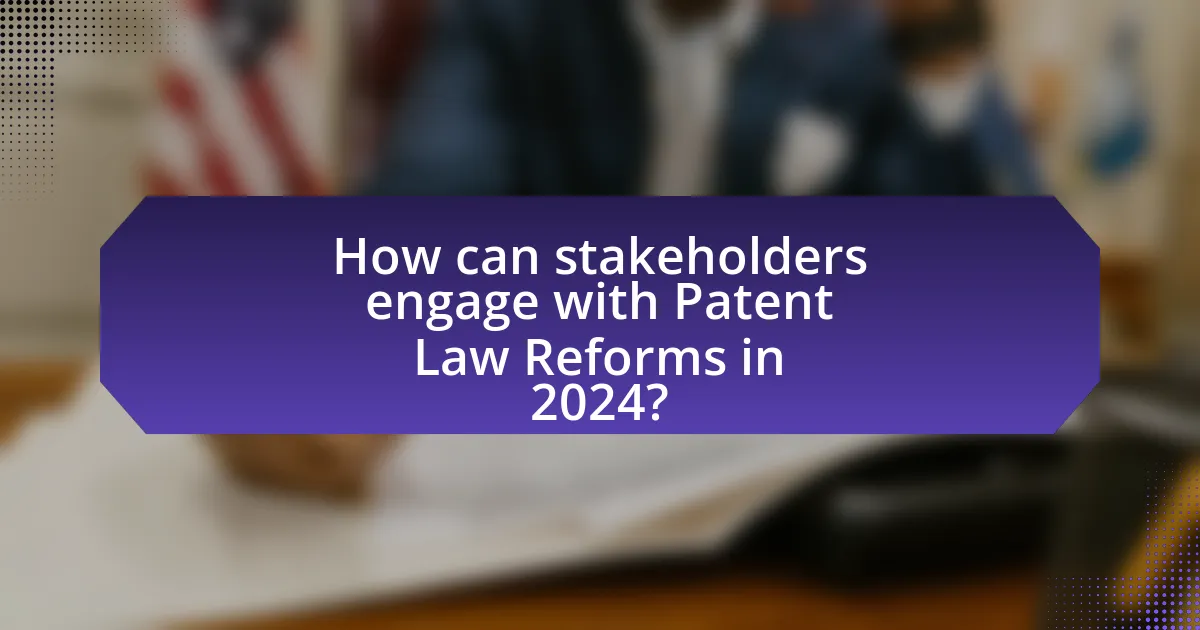
How can stakeholders engage with Patent Law Reforms in 2024?
Stakeholders can engage with Patent Law Reforms in 2024 by actively participating in public consultations and submitting feedback on proposed changes. This engagement is crucial as it allows stakeholders, including inventors, businesses, and legal professionals, to voice their concerns and suggestions, influencing the legislative process. For instance, the U.S. Patent and Trademark Office (USPTO) often holds forums and invites comments on patent policy, providing a platform for stakeholders to contribute their insights. Engaging in these discussions can lead to more balanced and effective patent laws that reflect the needs of various parties involved in innovation and intellectual property.
What resources are available for understanding Patent Law changes?
Resources available for understanding Patent Law changes include government websites, legal databases, and scholarly articles. The United States Patent and Trademark Office (USPTO) provides official updates and guidelines on patent law changes. Legal databases like Westlaw and LexisNexis offer comprehensive access to case law, statutes, and legal commentary. Additionally, academic journals such as the “Journal of Intellectual Property Law” publish peer-reviewed articles that analyze recent developments in patent law. These resources collectively ensure that individuals and professionals stay informed about the evolving landscape of patent law.
Where can stakeholders find up-to-date information on reforms?
Stakeholders can find up-to-date information on reforms through official government websites, legal journals, and industry publications. These sources regularly publish updates on patent law reforms, including changes in legislation and policy analysis. For instance, the United States Patent and Trademark Office (USPTO) provides timely updates on patent law changes, while journals like the “Journal of Intellectual Property Law” offer in-depth articles on recent developments.
What role do professional organizations play in advocacy?
Professional organizations play a crucial role in advocacy by representing the interests of their members and influencing policy decisions. These organizations engage in lobbying efforts, provide expert testimony, and mobilize their members to participate in advocacy campaigns, thereby shaping legislation and regulations relevant to their fields. For instance, in the context of patent law reforms, organizations such as the American Intellectual Property Law Association actively advocate for changes that align with the interests of patent professionals and innovators, ensuring that their voices are heard in legislative discussions. This involvement is essential for promoting effective and fair patent policies that can impact innovation and economic growth.
How can individuals and companies influence Patent Law Reforms?
Individuals and companies can influence Patent Law reforms by actively engaging in advocacy, participating in public consultations, and collaborating with industry groups. Advocacy efforts can include lobbying government officials and legislators to promote specific changes that align with their interests, such as reducing patent litigation costs or enhancing patent quality. Participation in public consultations allows stakeholders to voice their opinions and provide feedback on proposed reforms, ensuring that their perspectives are considered in the legislative process. Additionally, collaboration with industry groups can amplify their influence, as collective efforts often carry more weight in discussions with policymakers. Historical examples include the 2011 America Invents Act, which was shaped by extensive lobbying from technology companies seeking to reform the patent system to better suit their needs.
What methods can be used to participate in public consultations?
Public consultations can be participated in through various methods, including online surveys, public meetings, written submissions, and stakeholder workshops. Online surveys allow individuals to provide feedback conveniently, while public meetings facilitate direct interaction with policymakers. Written submissions enable detailed input on specific issues, and stakeholder workshops encourage collaborative discussions among affected parties. These methods ensure diverse perspectives are considered in the decision-making process, enhancing the effectiveness of public consultations.
How can stakeholders collaborate to promote effective reforms?
Stakeholders can collaborate to promote effective reforms by establishing multi-sector partnerships that leverage diverse expertise and resources. These partnerships can facilitate knowledge sharing, align objectives, and create a unified approach to reform initiatives. For instance, in the context of patent law reforms, collaboration among government agencies, industry representatives, and academic institutions can lead to comprehensive policy frameworks that address the needs of all parties involved. Evidence from successful reform efforts, such as the European Patent Convention, demonstrates that stakeholder engagement enhances the legitimacy and effectiveness of reforms by incorporating varied perspectives and fostering consensus.
What practical steps can be taken to adapt to Patent Law changes?
To adapt to changes in Patent Law, organizations should conduct a comprehensive review of their existing patent portfolios and strategies. This review allows entities to identify potential vulnerabilities and areas for improvement in light of new regulations. Additionally, companies should invest in ongoing education and training for their legal and R&D teams to ensure they are aware of the latest legal developments and compliance requirements. Engaging with patent attorneys who specialize in recent law changes can provide tailored guidance and strategies for navigating the evolving landscape. Furthermore, organizations should consider implementing a proactive approach to filing patents, ensuring that they align with the latest legal standards and practices. These steps are essential for maintaining competitive advantage and legal compliance in a dynamic patent environment.
How should companies revise their patent strategies in light of reforms?
Companies should revise their patent strategies by focusing on increased collaboration and adaptive licensing models in response to recent patent law reforms. These reforms often emphasize transparency and accessibility, which necessitates a shift from traditional, siloed approaches to more open innovation practices. For instance, companies can benefit from engaging in cross-licensing agreements that allow for shared use of patented technologies, thereby reducing litigation risks and fostering innovation. Additionally, firms should invest in monitoring legislative changes and judicial interpretations to ensure compliance and leverage new opportunities for patent protection. This proactive approach is supported by the trend of courts favoring more flexible interpretations of patentability, as seen in recent rulings that prioritize innovation over strict adherence to previous standards.
What common pitfalls should be avoided during the transition period?
Common pitfalls to avoid during the transition period in patent law reforms include inadequate stakeholder communication, which can lead to misunderstandings and resistance to change. Effective communication ensures that all parties, including inventors, businesses, and legal professionals, are aligned with the new regulations. Another pitfall is insufficient training on new processes, which can result in errors and inefficiencies. Providing comprehensive training programs helps stakeholders adapt smoothly to the changes. Additionally, neglecting to monitor the implementation of reforms can hinder their effectiveness; regular assessments allow for timely adjustments and improvements. These pitfalls are critical to address to ensure a successful transition in patent law reforms.
